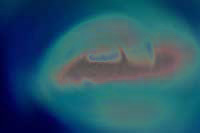
Virtual
Cannibals ....
3BACK
| HOME | NEXT4
_____________________________________________________
In some ways, we must change how we think about cannibalism when we think
about virtual worlds, because virtuality has changed how we think about
the body. In an article entitled "What Do Cyborgs Eat? Oral Logic
in an Information Society," Margaret Morse considers the fusing of
electronic and organic matter in what she calls "an oral logic of
incorporation" (158), which she characterizes as cannibalistic. She
sees our cyborgification as a merging of two bodies (one electronic, one
organic), and the question of who is eating what or what is eating whom
depends on the size of each body involved. So, for example, if we are
talking about "smart drinks" and vitamin pills, then it is the
organic matter eating the technology; on the other hand, if we are talking
about downloading our brains into a hard drive, then it is the hard drive
doing the consuming (162). Either way, Morse compares these forms of cannibalism
to the cannibalistic mother-child relationship: ." . . the scientist
only apparently usurps motherhood with the extrauterine development of
the robot-child; his subsequent immersion in a sea of data is implicitly
a symbolic return to the first inner space, the womb, much as the fantasy
of being eaten by machines evokes fantasies of being eaten or destroyed
by the mother" (163).
This feminine imagery is interesting when compared to traditional understandings of the body's relationship to machine. Foucault would say that we internalize that physical space that disciplines/punishes--that, for example, we discipline the body to conform to our machine. Interestingly enough, these images of conformation can be cannibalistic as well, but they are perhaps more likely to evoke images of cutting and fragmentation than womb-like envelopment. Foucault states that the place of discipline is usually cellular (e.g., the prison cell; the classroom--Foucault 145). In the case of the computer, I suggest that the cellular space is that of the computer screen. Lev Manovich, quoting Barthes, notes that the screen representation itself is an act of cutting (104). There is the frozen (or moving) subject "cut" by a rectangle, which defines the composition, beyond whose edges is nothingness. So it can be said that the viewer, by virtue of internalizing the screen, is "cut" into submission. In addition, it can be said that we become cognitively fragmented by the Internet environment, by virtue of links, for example, which fragment information (interestingly enough, the OED shows that if we trace the history of the word "link," we find the Germanic word "glink," which means "articulation" or "joint," so there is not only the idea that we are being cognitively fragmented, but also being torn from limb to limb). Morse's imagery, in comparison, sees us enveloped.
In her book entitled The War of Desire and Technology at the Close of the Mechanical Age, Allucquere Rosanne Stone is interested in observing what happens when body, desire, and social identity merge with virtual technology. Rather than believing that our social identities in cyberspace are merely products of cannibalism, Stone believes electronic media can be genuinely "transformative" (86). Her studies in this area began with observations of female phone sex workers who were able to "compress" sensual data and create the sense of a full sexual experience through the simple audio capabilities of a phone line. Her interests then extended into studies of the Internet. Stone believes that cyberspace is a metaphor for a network of electronic communication prosthetics creating "technosociality" (35). While acknowledging that this network reinforces old monolithic power structures, she also asserts that "some of the interactions are novel, strange, perhaps transformative, and certainly disruptive of many traditional attempts at categories" (36). Beginning with the admission that communication/experience in cyberspace is "fragmented, complex, defracted through the lens of technology" (36), Stone explores implications of this fragmentation, comparing it to the phenomenon of multiple personalities and the myth of Isis/Osirus (which were originally associated by Colon Roth in Multiple Personality Disorder, 1986). In the Roman myth, Osirus, king of the earth, is cut into pieces by his brother named Set. Isis gathers up the pieces, embalms them, and then reconstructs Osirus as king of the netherworlds. While Colon explores this myth as a metaphor for multiple personality disorder (and as a replacement of the Oedipus complex metaphor), Stone explores both as metaphors for social identity in cyberspace. So, on one hand we think of multiple personality disorder as a split from a central "personality," in the same way that we might see the multifaceted Internet as merely a variation of the same monolithic/patriarchal power structure; on the other hand, Stone is exploring the idea of legitimizing multiplicity--for example, viewing multiple Internet identities as part of a fluid construction of identity, and viewing "the multiple" as the opposite of the unified power structure that we associate with the patriarchal tradition:
| The multiple is the enantiomorph, the opposite, of the unitary monistic identity that location technology produces. The multiple is the socializer within the computer networks, a being warranted to, but outside of, a single physical body (43). |
Here, the
very model of cannibalization stemming from traditional power sources
becomes altered as our model of identity in cyberspace becomes altered.
Multiplicity, traditionally recognized as a product of violence (and even
represented by the Isis/Osirus myth of fragmentation) becomes a possible
model of wholeness. Stone cites Roth's words in this context, his notion
that the Isis/Osirus myth "illustrates the fragmentation, death,
healing, and resurrection of the self in new form" (48). In this
case, it is the female image we see picking up the fragmenting/cannibalized
pieces and healing them in the computer "womb." From this point
of view, cybercannibalism becomes a regenerative process.
CONTINUE
4